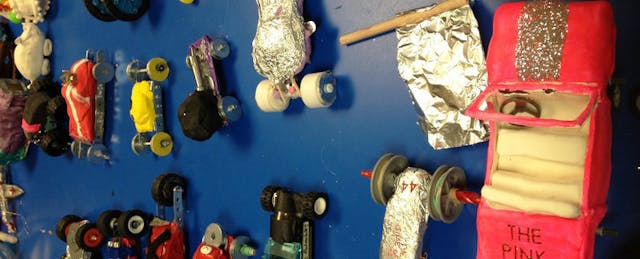Eyes closed, I could hear kids screaming around me. Screaming with energy, enthusiasm--cheering. I opened my eyes not to a Justin Bieber concert with flashing lights, but to a school cafeteria and the sight of two hand-made cars careening down a track. “Go, Pink Package!” “Go, District Twelve!” Students, teachers and parents chanted deafeningly for their top picks until their throats were raw and the results final: X-Solo, the only three-wheeler in the competition had taken first place in the first Marymount Nerd Derby.
This doesn’t usually happen in a school setting. This unique and intense experience was due to the energy and passion of teacher-maker Jaymes Dec, who is the Technology Integrator and FabLab Coordinator at the Marymount School, a private all-girls school on the Upper East Side of Manhattan.
In this age of accountability and standardized testing it can be challenging to find pockets of authentic innovation occurring within the school setting. Innovative pedagogy takes a careful balance of risk-taking, teacher confidence and support from school leadership. A visit to Marymount and some deep conversation with Dec, shed some light on exactly what can happen when that balance is achieved. The Nerd Derby project is a perfect example of the type of balance needed for real educational pioneers to innovate in schools. Working closely with Lesa Wang, Marymount’s Art & Design teacher, Dec was able to bring the Nerdy Derby to life at Marymount.

Nerdy Derby Goes to School
The Nerdy Derby is a miniature car building and racing competition organized and designed by a group of students at NYU’s ITP program. The project was inspired by the Pinewood Pro derby used by the Boy Scouts of America, which is part of what made it so clever that Dec and Wang brought the Derby to their school. The first race was held at the World Maker Faire in September 2012 and currently the derby continues on at the NY Hall of Science. At this point, you might ask: “How do I get an installation from the Maker Faire into my school cafeteria?” Dec offers a few words to describe the process: asking, hounding and begging the designers.
Marymount students spent a week building and iterating their vehicles with partners. The "Garbage Truck" raised a few eyebrows when it demonstrated its speed and agility. The crowd roared approval for best-named contenders, Hunger Games-inspired "District 12" and the ever-so-chic "Pink Package." Yet in the spirit of such crowd pleasers, the three-wheel car, "X-Solo" won. The builders of the big winner think it was a mixture of creative thinking and a certain weight added to the side of their car that made it undefeatable. They also admitted that it was their fifth car and completely different from their original design.
The momentum for this mini-unit stemmed from an authentic and undeniable enthusiasm amongst staff and students at the school. There was a seriousness about the competition that made every participant—whether builder or audience member--lose themselves in the moment. Fourth and fifth graders showed their support by making flags to represent their car picks. The Marymount school maintenance crew got involved, bringing risers into the cafeteria to create the vibe of a real competition. There was a Marymount Derby bracket built on Challonge that projected real-time updates. Every heart in that cafeteria was captivated, including mine.

It Takes a Village
While Dec is quite an innovative character, he did not make Marymount’s first Nerdy Derby happen alone. In fact, it is his team and their process that make this project so challenging to replicate at other schools. Dec and Wang developed a plan to get teachers across the curriculum involved. The Nerdy Derby project reach across content areas to include ELA, Math, Science, Art and Technology. In fact, while the designers were setting up the derby in the cafeteria, adults from around the school seemed to find their way downstairs, cars in hand, eager to race. Every teacher in the building knew what was happening and wanted to partake. Today, teachers are often overwhelmed and bogged down by paperwork and bureaucracy that there is little time to feel enthused over teaching and learning. This project brought out the competition, the underdog and the maker in many of the staff members at Marymount.
Now let's evolve the Derby a step further. Imagine working in a school where the school leader, in this case Headmistress Concepcion Alvar says, “Let’s bring the Nerdy Derby to our school. We’ll do it in the cafeteria!” During the competition, I sat with Headmistress Alvar, who is a true visionary. She explained how in sixth and seventh grade, teachers start to lose student engagement. She encourages them to look towards projects like these to bring them back.
Alvar was glowing the entire time, raving about her staff and how they came together to do something that represented the best kind of learning. It was a great reminder of how a school leader’s role is to inspire and encourage the staff to hone their teaching practice. At one point she said, “Just the other day we were setting off rockets in our other building, on this grand staircase…it was such a sight!” In that moment, it became clear how closely correlated school leadership and innovation really are.
At this point, you might ask yourself: “How challenging would it be to replicate this project in my school?” According to Dec and Wang, it took three weeks to plan and purchase the supplies, and one week to implement in classrooms. A $1,000 budget provided 40 sixth graders with the experience of building and iterating their cars to prime them for the big competition. Many of the materials are reusable; in fact, the budget covered extra materials that are now left for a new project.
The cars were built out of inexpensive, crafty materials such as clay, Popsicle sticks and washers. During a post-competition student feedback session, the students advised teachers to buy more washers next time, as this was a favorite material that caused some hoarding amongst the tweens. Teachers took notes on the student feedback so I’d guess there will be a meeting about reallocating funding for next year.

Can We Measure Maker-Learning?
Great teachers put student growth at the forefront of everything they do and Dec, Wang and the team at Marymount definitely did with the Nerdy Derby project. During the opening, Dec invited sixth graders to share some of their findings with the fourth and fifth graders in the audience. Let’s just say their dialogue was flooded with content-area vocabulary: aerodynamics, friction, center of gravity and iteration. Their competency was remarkable.
In chatting with teachers, some of the biggest lessons learned were about risk-taking, mistake-making, iteration and collaboration. There was even a lesson about values in how they awarded the cars: there were winners for speed, best design and best collaboration rather than simply 1st, 2nd and 3rd place. One builder was completely flustered at her vehicle’s slow performance, expressing that she had done extensive home-research on the Nerdy-Derby website to maximize her vehicle’s speed. While some might console her, I was just in awe of the fact that she had taken control of her learning and allowed it to follow her home.
Thought student learning was evident, the major challenge for these types of projects is finding ways to measure progress. Dec was humble instead of his victories: “The first time you try something of this scale, you learn a lot--assessment is one of the pieces I’ll reflect on for next year.” There are clear areas to measure but its about defining how to measure growth and finding a way to ensure that measuring growth doesn’t compete with enthusiasm for learning and heightened engagement.


